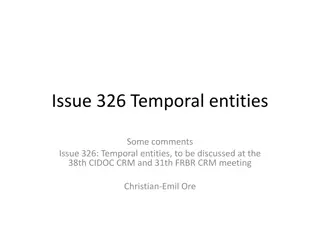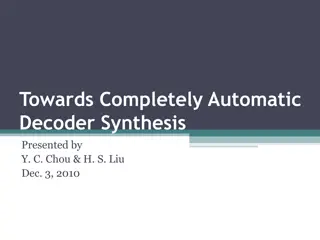Understanding Entity-Relationship Diagrams (ERD)
An Entity-Relationship Diagram (ERD) is a vital data modeling technique for visualizing an information system's entities and their relationships. This graphical representation helps in database design by defining entities, analyzing interactions, and determining cardinality. Entities represent real-
1 views • 40 slides
Discussion on Temporal Entities and Simultaneity in CIDOC CRM Meeting
Temporal entities and the modeling of simultaneity in CIDOC CRM are under discussion at the upcoming meeting. The current approach considers the cardinality of certain relations, aiming to streamline the representation of time-spans and spacetime volumes. The evolving perspectives on the spatial com
3 views • 5 slides
Representation of Abstract Groups through Graphs
Explore the representation of abstract groups as automorphism groups of graphs, touching on topics such as the existence of graphs whose automorphism groups are isomorphic to given abstract groups, the cardinality of connected graphs satisfying specific properties, and questions regarding the cardin
0 views • 16 slides
Mastering Power BI Strategies for Effective Data Modeling at Dynamic Communities 2022
Unlock the secrets of Power BI data modeling with expert insights from Nick Talsma at the largest independent gathering of Microsoft users. Explore topics such as storage options, relationships, cardinality, and more to enhance maintenance, performance, and cost efficiency. Discover the significance
0 views • 11 slides
Understanding Set Theory in Software Engineering Lecture
Sets, relations, and functions are foundational concepts in set theory, which is crucial in software engineering. This lecture covers topics such as types of sets, operations, relations, functions, set cardinality, subsets, and proper subsets. Explore the fundamentals of set theory with practical ap
0 views • 28 slides
Exploring Infinity: From Countable Integers to the Unbounded Real Numbers
Delve into the realm of infinity, where the concept transcends our finite understanding. Discover how the set of positive integers, even numbers, all integers, positive rational numbers, and real numbers each showcase a distinct level of infinity. Explore the notion of cardinality, bridging the gap
0 views • 9 slides
Understanding Sets in Mathematics
Sets in mathematics are collections of objects where the order does not matter, and elements are unique. This concept explores the definition of sets, examples, important sets like natural numbers, integers, and rationals, equality of sets, cardinality, finite and infinite sets, and the power set. S
1 views • 19 slides
Understanding Set Operations
Explore the concepts of set operations including union, intersection, disjoint sets, cardinality of unions, and the difference of two sets. Learn definitions, examples, and applications of these fundamental set theory operations.
0 views • 14 slides
Advances in Completely Automatic Decoder Synthesis
This presentation by Y.C. Chou and H.S. Liu on "Towards Completely Automatic Decoder Synthesis" covers topics such as motivation, preliminary concepts, main algorithms, and experimental results in the field of communication and cryptography systems. The content delves into notation, SAT solvers, Cra
0 views • 35 slides
Understanding Sets and Functions in ICS 6D
Sets are collections of items where order doesn't matter, and functions define relationships between sets. Learn about cardinality, famous sets, set operations, subsets, and the power set in this overview. Explore examples and notations to enhance your understanding of these fundamental concepts.
0 views • 29 slides
Understanding Microsoft Enterprise Consortium Database Relationships
Explore the fundamentals of data models, relationships, and cardinality in the Microsoft Enterprise Consortium Database. Learn about entities, attributes, identifiers, and the different types of relationships like one-to-many, many-to-many, and one-to-one. Gain insights into the degree of relationsh
0 views • 10 slides
Entity-Relationship Modeling Examples & Refinement for Data Management
Explore various scenarios related to entity-relationship modeling, including cardinality identification, eliminating unnecessary details, and refining business rules. Examples touch upon scenarios in healthcare, education, organizational hierarchies, and employee data management.
0 views • 9 slides











